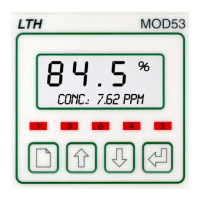1 Introduction
5
1 Introduction
ABOUT THE MOD53
The MOD53 is a microprocessor controlled dissolved oxygen measurement
instrument. It uses a multifunction LCD to display readings and provide feedback
to the operator. Different options provide fully configurable control, alarm and
feedback with up to four relays and two 0/4-20mA current output sources.
UNIT SPECIFICATION
Sensor Input Galvanic (Mackereth) 0 to 9.999mA or Polargraphic
(Clark) 0 to 500.0nA.
Sensor Bias Voltage Software Programmable, -1.000 to +1.000V,
Resolution ±1mV, Output Accuracy ±3mV
Sensor membrane
correction factor
Software Programmable
0 to 9999
Sensor Cable Up to 100 metres
Ranges of
Measurement
0 - 199.9 % saturation, 0 - 30.00 ppm Concentration,
0 – 999.9 mmHg (Calibration specific)
0 – 9999 mBar pO
2
(Calibration specific)
Accuracy
±3µA (Galvanic Mode), ±1.0nA (Polargraphic Mode)
Linearity
±0.1% of Range
Repeatability
±0.1% of Range
Temperature Sensor 4 wire interface, operating with up to 100 metres of
cable. Software selectable sensor type including
PT100 & PT1000 RTD.
Measurement Range
-50°C to +300°C (when using PT100 or PT1000)
Temperature Accuracy
±0.2°C (Dependant on Sensor Configuration)
Operator Adjustment
(Temperature)
± 50°C, or ± 122°F
Temperature
Compensation
Automatic, or Manually set from 0°C to 100°C
Pressure
Compensation
Actively from 4-20 mA input (Direct or 24V loop
powered from the MOD53.) Software Scalable.
or User Programmable from 0.50 – 9.99 bar
With user Selectable Pressure Damping
Salinity Compensation User Programmable from 0 – 40.0 ppt
Ambient Operating
Temperature
-20°C to +50°C (-4°F to +122°F) for full specification.
Ambient temperature
variation
±0.01% of range / °C (typical)

